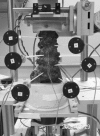Biomechanical evaluation of posterior lumbar dynamic stabilization: an in vitro comparison between Universal Clamp and Wallis systems
- PMID: 21132335
- PMCID: PMC3030709
- DOI: 10.1007/s00586-010-1641-1
Biomechanical evaluation of posterior lumbar dynamic stabilization: an in vitro comparison between Universal Clamp and Wallis systems
Abstract
Treatment of chronic low back pain due to degenerative lumbar spine conditions often involves fusion of the symptomatic level. A known risk of this procedure is accelerated adjacent level degeneration. Motion preservation devices have been designed to provide stabilization to the symptomatic motion segment while preserving some physiologic motion. The aim of this study was to compare the changes in relative range of motion caused as a result of application of two non-fusion, dynamic stabilization devices: the Universal Clamp (UC) and the Wallis device. Nine fresh, frozen human lumbar spines (L1-Sacrum) were tested in flexion-extension, lateral bending, and axial rotation with a custom spine simulator. Specimens were tested in four conditions: (1) intact, (2) the Universal Clamp implanted at L3-4 (UC), (3) the UC with a transverse rod added (UCTR), and (4) the Wallis device implanted at L3-4. Total range of motion at 7.5 N-m was determined for each device and compared to intact condition. The UC device (with or without a transverse rod) restricted motion in all planes more than the Wallis. The greatest restriction was observed in flexion. The neutral position of the L3-4 motion segment shifted toward extension with the UC and UCTR. Motion at the adjacent levels remained similar to that observed in the intact spine for all three constructs. These results suggest that the UC device may be an appropriate dynamic stabilization device for degenerative lumbar disorders.
Figures




Similar articles
-
Non-fusion instrumentation of the lumbar spine with a hinged pedicle screw rod system: an in vitro experiment.Eur Spine J. 2009 Oct;18(10):1478-85. doi: 10.1007/s00586-009-1052-3. Epub 2009 Jun 6. Eur Spine J. 2009. PMID: 19504129 Free PMC article.
-
The effect of design parameters of dynamic pedicle screw systems on kinematics and load bearing: an in vitro study.Eur Spine J. 2011 Feb;20(2):297-307. doi: 10.1007/s00586-010-1620-6. Epub 2010 Nov 26. Eur Spine J. 2011. PMID: 21110209 Free PMC article.
-
The effect of dynamic, semi-rigid implants on the range of motion of lumbar motion segments after decompression.Eur Spine J. 2008 Aug;17(8):1057-65. doi: 10.1007/s00586-008-0667-0. Epub 2008 May 21. Eur Spine J. 2008. PMID: 18493802 Free PMC article.
-
[Multi-segment ventral stabilization of the lumbar spine: a comparative biomechanical study].Z Orthop Ihre Grenzgeb. 1995 May-Jun;133(3):242-8. doi: 10.1055/s-2008-1039444. Z Orthop Ihre Grenzgeb. 1995. PMID: 7610706 Review. German.
-
Current concepts of spondylosis and posterior spinal motion preservation for radiologists.Skeletal Radiol. 2021 Nov;50(11):2169-2184. doi: 10.1007/s00256-021-03840-6. Epub 2021 Jun 15. Skeletal Radiol. 2021. PMID: 34131792 Review.
Cited by
-
Stability Evaluation of Different Oblique Lumbar Interbody Fusion Constructs in Normal and Osteoporotic Condition - A Finite Element Based Study.Front Bioeng Biotechnol. 2021 Nov 5;9:749914. doi: 10.3389/fbioe.2021.749914. eCollection 2021. Front Bioeng Biotechnol. 2021. PMID: 34805108 Free PMC article.
-
Bone resorption during the first year after implantation of a single-segment dynamic interspinous stabilization device and its risk factors.BMC Musculoskelet Disord. 2015 May 14;16:117. doi: 10.1186/s12891-015-0561-y. BMC Musculoskelet Disord. 2015. PMID: 25971589 Free PMC article.
-
Limitations of current in vitro test protocols for investigation of instrumented adjacent segment biomechanics: critical analysis of the literature.Eur Spine J. 2015 Sep;24(9):1882-92. doi: 10.1007/s00586-015-4040-9. Epub 2015 Jun 3. Eur Spine J. 2015. PMID: 26038156 Review.
-
Study of bone-screw surface fixation in lumbar dynamic stabilization.Chin Med J (Engl). 2015 Feb 5;128(3):368-72. doi: 10.4103/0366-6999.150107. Chin Med J (Engl). 2015. PMID: 25635433 Free PMC article.
-
Biomechanical preservation of lumbar spine stability and motion with an intraosseous implant following vertebral body osteotomy.Eur Spine J. 2025 Jun;34(6):2467-2477. doi: 10.1007/s00586-025-08871-4. Epub 2025 Apr 19. Eur Spine J. 2025. PMID: 40252084
References
-
- Throckmorton TW, Hilibrand AS, Mencio GA, Hodge A, Spengler DM. The impact of adjacent level disc degeneration on health status outcomes following lumbar fusion. Spine. 2003;28:2546–2550. - PubMed
-
- Dubois B, Germay B, Schaerer NS, Fennema P. Dynamic neutralization: a new concept for restabilization of the spine. In: Szpalski M, Gunzburg R, Pope MH, editors. Lumbar segmental instability. Philadelphia: Lippincott/Williams & Wilkins; 1999. pp. 233–240.
-
- Korovessis P, Papazisis Z, Koureas G, Lambiris E. Rigid, semirigid versus dynamic instrumentation for degenerative lumbar spinal stenosis: a correlative radiological and clinical analysis of short-term results. Spine. 2004;29:735–742. - PubMed
-
- Shim CS, Park SW, Lee SH, Lim TJ, Chun K, Kim DH. Biomechanical evaluation of an interspinous stabilizing device, locker. Spine. 2008;33:E820–E827. - PubMed
Publication types
MeSH terms
LinkOut - more resources
Full Text Sources

